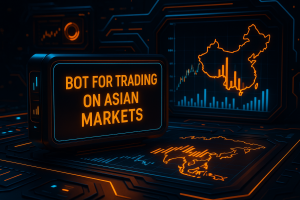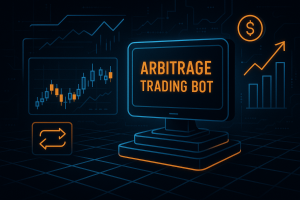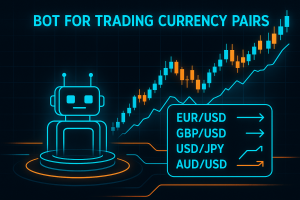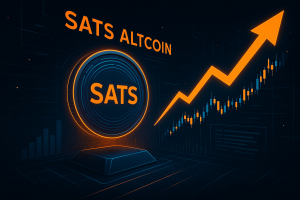Commodity trading bot

Crude oil, gas, gold, silver, and other commodities are all traded on global exchanges, and managing deals with these resources demands knowledge, experience, and speed. That’s why an increasing number of traders turn to automated systems – trading bots capable of independently analysing the market and executing trades. A commodity trading bot has become more than just a tool; it’s a genuine assistant in an intensely competitive environment.
A commodity trading bot is a programme built on algorithms that can detect market changes and carry out trading operations without human intervention. It can be configured according to specific parameters, such as the type of commodity, target profit level, acceptable losses, and other conditions. Working according to a predetermined strategy, the bot aims to generate profits while minimising risks.
One of the key advantages of a trading bot is its speed in processing information. Commodity prices can fluctuate every second, especially during times of economic or geopolitical upheaval. In such situations, every fraction of a second counts. The bot can react instantly to market movements, opening or closing positions without losing precious time.
Another major benefit is its ability to trade around the clock. Unlike a trader, who cannot monitor the market incessantly, a bot operates 24/7. This is particularly advantageous in commodities trading, where news, OPEC reports, weather conditions, and other external factors can influence prices at any moment. The bot doesn’t sleep, get distracted, or succumb to emotions.
Analytical capabilities are yet another strong point. It can process multiple streams of data simultaneously – price charts, trading volumes, support and resistance levels, economic news, inventory reports, and even climate data. Modern bots employ technical and fundamental analysis, with some even using machine learning and artificial intelligence to forecast market movements.
Flexibility in configuration is also crucial. Users can set their own trading parameters, select specific assets (such as gold or oil), establish risk limits, or choose a strategy – whether aggressive, moderate, or conservative. Some bots support automatic strategy adjustment based on market conditions.
However, despite all these advantages, using a bot requires a mindful approach. It’s important not to view it as a guarantee of profit. It’s merely a tool – its effectiveness depends on the quality of its settings, chosen strategy, and prevailing market conditions. Bots can make mistakes, especially when faced with unconventional situations or sharp price jumps. Therefore, traders must not only configure their bots carefully but also regularly monitor their performance.
It’s also essential to consider legal and ethical aspects. Some exchanges restrict the use of trading algorithms, and trading certain commodities may be regulated by government authorities. It’s wise to ensure in advance that automated trading is lawful on the platform you choose.
In conclusion, a commodity trading bot can significantly ease the processes of analysis and decision-making in a complex and volatile market. It grants access to opportunities that were once only available to professional traders with extensive experience and analytical teams.
Category news: Markets and Instruments Product and Bot Features
-

How to install the trading bot
In today’s digital age, trading has long since moved beyond its traditional form. Increasingly, it’s not humans but algorithms – trading bots – that handle financial operations. These electronic assistants can trade around the clock, without fatigue, distraction, or emotion. However, for a bot to become truly effective, it must be installed and configured correctly. […]
-

Bot for trading on Asian markets
Cryptocurrencies – decentralised digital assets traded around the clock and across the globe – are drawing increasing attention. One of the most dynamic and active segments is the Asian crypto market. It is home to major exchanges, millions of retail investors, and cutting-edge blockchain projects. With trading velocity and volumes so high, manual control is […]
-

Arbitrage trading bot
The automation of trading processes is becoming increasingly popular. One of the most interesting and promising tools in this area is the arbitrage trading bot. This software algorithm, capable of executing trades without human intervention, represents a fusion of programming and financial analytics at a very high level. Arbitrage trading is a strategy in which […]
-

Bot for trading currency pairs
The world of financial markets is constantly evolving, with technology playing an ever-greater role each year. One of the most significant innovations in this space has been the trading bot – software capable of automatically buying and selling currencies according to predefined rules. These bots are especially popular on the Forex market, where currency pairs […]
Latest news
-

How to install the trading bot
In today’s digital age, trading has long since moved beyond its traditional form. Increasingly, it’s not humans but algorithms – trading bots – that handle financial operations. These electronic assistants can trade around the clock, without fatigue, distraction, or emotion. However, for a bot to become truly effective, it must be installed and configured correctly. […]
-

Bot for trading on Asian markets
Cryptocurrencies – decentralised digital assets traded around the clock and across the globe – are drawing increasing attention. One of the most dynamic and active segments is the Asian crypto market. It is home to major exchanges, millions of retail investors, and cutting-edge blockchain projects. With trading velocity and volumes so high, manual control is […]
-

SATS
SATS is a “meme” or experimental token built on the BRC-20 standard, designed to highlight its connection to Bitcoin and its smallest unit. Issued by an anonymous team, it doesn’t feature complex smart contracts like Ethereum tokens, but instead focuses on symbolism and crypto-culture. What backs it From a backing perspective, SATS has several defining […]
-

Arbitrage trading bot
The automation of trading processes is becoming increasingly popular. One of the most interesting and promising tools in this area is the arbitrage trading bot. This software algorithm, capable of executing trades without human intervention, represents a fusion of programming and financial analytics at a very high level. Arbitrage trading is a strategy in which […]

